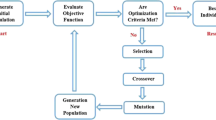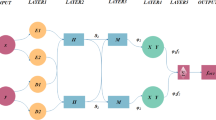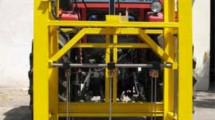Abstract
This paper extends hybrid-type optimization models of genetic algorithm adaptive network-based fuzzy inference system (GA-ANFIS) for predicting the soil permeability coefficient (SPC) of different types of soil. In these models, GA optimizes parameters of a subtractive clustering technique that controls the structure of the ANFIS model’s fuzzy rule base. Simultaneously, a hybrid leaning algorithm is employed in the ANFIS, as a trained fuzzy inference system (FIS), which optimally determines the parameter sets of the examined FISs in ANFIS. Using an updated large database of SPCs consisting of 338 fine-grained, 178 mixed and 94 granular soil samples, GA-ANFIS framework constructs different models of predicting the permeability coefficient of respectively fine-grained, mixed and granular soils. A fuzzy C-mean technique has been used to cluster the entire data samples of each type of soil and divide them uniformly into training and testing data sets. Different prediction models of SPC have been trained and tested for each of the three soil types, and the appropriate models have been selected. The selected models have been compared with ANN and modified-by-GA empirical prediction models. Results show that the constructed GA-ANFIS models outperform the other models in terms of the prediction accuracy and the generalization capability.












Similar content being viewed by others
References
Hazen A (1892) Some physical properties of sands and gravels. Massachusetts State Board of Health Annual Report, 539–556
Kenny TC, Lau D, Ofoegbu GI (1984) Permeability of compacted granular materials. Can Geotech J 21:726–729
Cedergren HR (1988) Seepage drainage and flow nets, 3rd edn. Wiley, Hoboken
D’Appolonia DJ (1980) Soil-bentonite slurry trench cutoffs. J Geotech Geoenviron Eng ASCE 106(4):399–417
Daniel D (1987) Earthen liners for land disposal facilities. Geotechnical practice for waste disposal ‘87, vol 13. ASCE, New York, pp 21–39
Kenney TC, Van Veen WA, Swallow MA, Sungaila MA (1992) Hydraulic conductivity of compacted bentonite-sand mixtures. Can Geotech J 29(3):364–374
Ryan CR (1987) Vertical barriers in soil for pollution containment. Geotechnical practice for waste disposal, vol 13. ASCE, New York, pp 182–204
Shelley TL, Daniel DE (1993) Effect of gravel on hydraulic conductivity of compacted soil liners. J Geotech Eng 119(1):54–68
Shakoor A, Cook BD (1990) The effects of stone content, size, and shape on the engineering properties of a compacted silty clay. Bull Assoc Eng Geol 27:245–253
Shafiee A (2008) Permeability of compacted granule-clay mixtures. Eng Geol 97(11):199–208
Lambe TW, Whitman RV (2008) Soil mechanics. SI version. Wiley India Pvt. Limited, Hoboken
Mesri G, Olson RE (1971) Mechanism controlling the permeability of clays. Clay Clay Miner 19:151–158
Mitchell JK, Soga K (2005) Fundamentals of soil behavior. Wiley, Hoboken
Cary AS, Walter BH, Harstad HT (1943) Permeability of mud mountain dam core material. Trans Am Soc Civ Eng 108:719–728
Acar YB, Olivieri I (1989) Pore fluid effects on the fabric and hydraulic conductivity of laboratory-compacted clay. Transport Res Record 1219:144–159
Cronican AE, Gribb MM (2004) Hydraulic conductivity prediction for sandy soils. Supplement entitled: equations for predicting hydraulic conductivity based on grain-size data. Ground Water 42:459–464
Amer AM, Awad AA (1974) Permeability of cohesionless soils. J Geotech Eng Div ASCE 100(GT12):1309–1316
Chapuis RP, Gill DE, Baass K (1989) Laboratory permeability tests on sand: influence of the compaction method on anisotropy. Can Geotech J 26:614–622
Odong J (2007) Evaluation of empirical formulae for determination of hydraulic conductivity based on grain-size analysis. J Am Sci 3(3):54–60
Alyamani MS, Sen Z (1993) Determination of hydraulic conductivity from complete grain-size distribution curves. Ground Water 31(4):551–555
Sperry JM, Peirce JJ (1995) A model for estimating the hydraulic conductivity of granular material based on grain shape, grain size, and porosity. Ground Water 33(6):892–898
Carrier DW (2003) Goodbye, hazen; hello, kozaney-carman. J Geotech Geoenviron Eng ASCE 129(11):1054–1056
Chapuis RP (2004) Predicting the saturated hydraulic conductivity of sand and gravel using effective diameter and void ratio. Can Geotech J 41(11):787–795
Kresic N (2007) Quantitative solutions in hydrogeology and groundwater modeling, 2nd edn. CRC Press, Taylor & Francis Group, Boca Raton
Raju PSRN, Pandian NS, Nagaraj TS (1995) Analysis and estimation of coefficient of consolidation. Geotech Test J 18(2):252–258
Chapuis RP (2012) Predicting the saturated hydraulic conductivity of soils: a review. Bull Eng Geol Environ 71(3):401–434
Taylor DW (2013) Fundamentals of soil mechanics. Literary Licensing LLC, Whitefish
Jang JR (1993) anfis: adaptive-network-based fuzzy inference system. IEEE Trans Syst Man Cybern 33(3):2889–2892
Najjar YM, Basheer IA (1996) Utilizing computational neural networks for evaluating the permeability of compacted clay liners. Geotech Geol Eng 14(3):193–212
Boroumand A, Baziar MH (2005) Determinations of compacted clay permeability by artificial neural networks. Proceedings of the ninth international water technology conference, Sharm El-Sheikh, March 17–20, pp 515–526
Sinha SK, Wang MC (2008) Artificial neural network prediction models for soil compaction and permeability. Geotech Geol Eng 26:47–64
Yilmaz I, Marschalko M, Bednarik M, Kaynar O, Fojtova L (2012) Neural computing models for prediction of permeability coefficient of coarse-grained soils. Neural Comput Appl 21:957–968
Arshad RR, Sayyad G, Mosaddeghi M, Gharabaghi B (2013) Predicting saturated hydraulic conductivity by artificial intelligence and regression models. ISRN Soil Sci, Article ID 308159, 8
Zanganeh M, Mousavi SJ, Etemad Shahidi AF (2009) A hybrid genetic algorithm-adaptive network-based fuzzy inference system in prediction of wave parameters. Eng Appl Artif Intell 22(8):1194–1202
Chiu SL (1994) Fuzzy model identification based on cluster estimation. J Intell Fuzzy Syst 2(3):267–278
Mousavi SJ, Ponnambalam K, Karray F (2007) Inferring operating rules for reservoir operations using fuzzy regression and ANFIS. Fuzzy Sets Syst 158(10):1064–1082
Bezdek JC (1981) Pattern recognition with fuzzy objective function algorithms. Kluwer Academic Publishers, Berlin
Demuth H, Beale M, Hagan M (2008) Neural network \({\rm toolbox}^{{\rm TM}}\) 6, user’s guide. The MathWorks, Inc, Natick
Cybenko G (1989) Approximation by superpositions of a sigmoidal function. Math Control Signals Syst 2(4):303–314
Hornik KM, Stinchcombe M, White H (1989) Multilayer feedforward networks are universal approximations. Neural Netw 2(5):359–366
Hecht-Nielson R (1987) Kolmogorov’s mapping neural network existence theorem. 1st IEEE ICNN, 3, San Diago
Kůrková V (1992) Kolmogorov’s theorem and multilayer neural networks. Neural Netw 5(3):501–506
Author information
Authors and Affiliations
Corresponding author
Rights and permissions
About this article
Cite this article
Ganjidoost, H., Mousavi, S.J. & Soroush, A. Adaptive Network-Based Fuzzy Inference Systems Coupled with Genetic Algorithms for Predicting Soil Permeability Coefficient. Neural Process Lett 44, 53–79 (2016). https://doi.org/10.1007/s11063-015-9479-5
Published:
Issue Date:
DOI: https://doi.org/10.1007/s11063-015-9479-5




